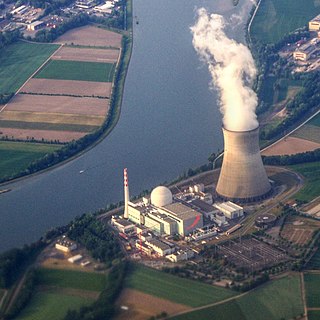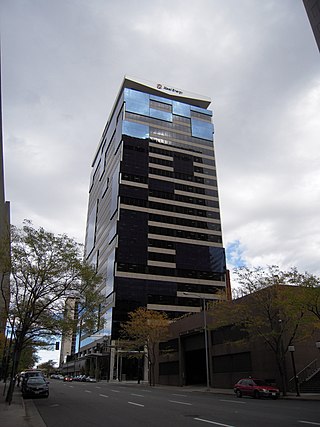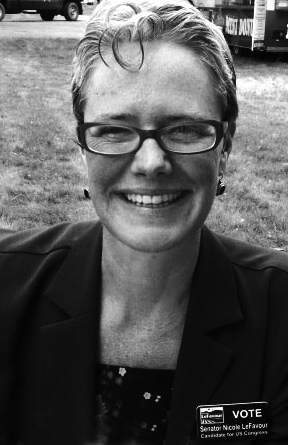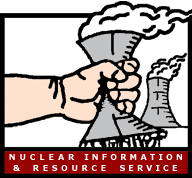Related Research Articles

Nuclear power is the use of nuclear reactions to produce electricity. Nuclear power can be obtained from nuclear fission, nuclear decay and nuclear fusion reactions. Presently, the vast majority of electricity from nuclear power is produced by nuclear fission of uranium and plutonium in nuclear power plants. Nuclear decay processes are used in niche applications such as radioisotope thermoelectric generators in some space probes such as Voyager 2. Generating electricity from fusion power remains the focus of international research.

Dry cask storage is a method of storing high-level radioactive waste, such as spent nuclear fuel that has already been cooled in the spent fuel pool for at least one year and often as much as ten years. Casks are typically steel cylinders that are either welded or bolted closed. The fuel rods inside are surrounded by inert gas. Ideally, the steel cylinder provides leak-tight containment of the spent fuel. Each cylinder is surrounded by additional steel, concrete, or other material to provide radiation shielding to workers and members of the public.

Areva S.A. is a French multinational group specializing in nuclear power headquartered in Courbevoie, France. Before its 2016 corporate restructuring, Areva was majority-owned by the French state through the French Alternative Energies and Atomic Energy Commission (54.37%), Banque publique d'investissement (3.32%), and Agence des participations de l'État (28.83%). Électricité de France, of which the French government has a majority ownership stake, owned 2.24%; Kuwait Investment Authority owned 4.82% as the second largest shareholder after the French state.

Idaho National Laboratory (INL) is one of the national laboratories of the United States Department of Energy and is managed by the Battelle Energy Alliance. Historically, the lab has been involved with nuclear research, although the laboratory does other research as well. Much of current knowledge about how nuclear reactors behave and misbehave was discovered at what is now Idaho National Laboratory. John Grossenbacher, former INL director, said, "The history of nuclear energy for peaceful application has principally been written in Idaho".

Xcel Energy Inc. is a U.S. regulated electric utility and natural gas delivery company based in Minneapolis, Minnesota, serving more than 3.7 million electric customers and 2.1 million natural gas customers across parts of eight states. It consists of four operating subsidiaries: Northern States Power-Minnesota, Northern States Power-Wisconsin, Public Service Company of Colorado, and Southwestern Public Service Co.

Duke Energy Corporation is an American electric power and natural gas holding company headquartered in Charlotte, North Carolina.

The Callaway Plant is a nuclear power plant located on 2,767 acres (1,120 ha) in Callaway County, Missouri, near Fulton, Missouri. It began operating on December 19, 1984. The plant, which is the state's only commercial nuclear unit, has one 1,190-megawatt Westinghouse four-loop pressurized water reactor and a General Electric turbine-generator. It is owned by the Ameren Corporation and operated by subsidiary Ameren Missouri. It is one of several Westinghouse reactors built to a design called Standard Nuclear Unit Power Plant System, or SNUPPS.

The Calvert Cliffs Nuclear Power Plant (CCNPP) is a nuclear power plant located on the western shore of the Chesapeake Bay near Lusby, Calvert County, Maryland in the Mid-Atlantic United States. It is the only nuclear power plant in the state of Maryland.

In the United States, nuclear power is provided by 92 commercial reactors with a net capacity of 94.7 gigawatts (GW), with 61 pressurized water reactors and 31 boiling water reactors. In 2019, they produced a total of 809.41 terawatt-hours of electricity, which accounted for 20% of the nation's total electric energy generation. In 2018, nuclear comprised nearly 50 percent of US emission-free energy generation.

Nicole LeFavour is an American politician and educator from Idaho who served as an Idaho State Senator from 2008 to 2012. LeFavour previously served in the Idaho House of Representatives from 2004 to 2008.
Nuclear power in Taiwan accounts for 2,945 MWe of capacity by means of 1 active plants and 2 reactors. In 2015, before the closure of 3 reactors, they made up around 8.1% of its national primary energy consumption, and 19% of its electricity generation. The technology chosen for the reactors has been General Electric BWR technology for 2 plants and Westinghouse PWR technology for the Maanshan Nuclear Power Plant. Construction of the Lungmen Nuclear Power Plant using the ABWR design has encountered public opposition and a host of delays, and in April 2014 the government decided to suspend construction.

The anti-nuclear movement in the United States consists of more than 80 anti-nuclear groups that oppose nuclear power, nuclear weapons, and/or uranium mining. These have included the Abalone Alliance, Clamshell Alliance, Committee for Nuclear Responsibility, Nevada Desert Experience, Nuclear Information and Resource Service, Physicians for Social Responsibility, Plowshares Movement, United Steelworkers of America (USWA) District 31, Women Strike for Peace, Nukewatch, and Women's International League for Peace and Freedom. Some fringe aspects of the anti-nuclear movement have delayed construction or halted commitments to build some new nuclear plants, and have pressured the Nuclear Regulatory Commission to enforce and strengthen the safety regulations for nuclear power plants. Most groups in the movement focus on nuclear weapons.
The 1970s proved to be a pivotal period for the anti-nuclear movement in California. Opposition to nuclear power in California coincided with the growth of the country's environmental movement. Opposition to nuclear power increased when President Richard Nixon called for the construction of 1000 nuclear plants by the year 2000.
Idaho Power Company (IPC) is a regulated electrical power utility. Its business involves the purchase, sale, generation, transmission and distribution of electricity in eastern Oregon and southern Idaho. It is a subsidiary of IDACORP, Inc. The company's 24,000-square-mile (62,000 km2) service area generally follows the area around the Snake River and its tributaries.
The Bell Bend Nuclear Power Plant was a proposed nuclear power plant, which would have been built on the Bell Bend of the Susquehanna River in Luzerne County, Pennsylvania adjacent to the Susquehanna Steam Electric Station.

More than 80 anti-nuclear groups are operating, or have operated, in the United States. These include Abalone Alliance, Clamshell Alliance, Greenpeace USA, Institute for Energy and Environmental Research, Musicians United for Safe Energy, Nevada Desert Experience, Nuclear Control Institute, Nuclear Information and Resource Service, Public Citizen Energy Program, Shad Alliance, and the Sierra Club. These are direct action, environmental, health, and public interest organizations who oppose nuclear weapons and/or nuclear power. In 1992, the chairman of the Nuclear Regulatory Commission said that "his agency had been pushed in the right direction on safety issues because of the pleas and protests of nuclear watchdog groups".

Between 2007 and 2009, 13 companies applied to the Nuclear Regulatory Commission (NRC) for construction and operating licenses to build 31 new nuclear power reactors in the United States. However, the case for widespread nuclear plant construction has been hampered due to inexpensive natural gas, slow electricity demand growth in a weak US economy, lack of financing, and safety concerns following the Fukushima nuclear accident at a plant built in the early 1970s which occurred in 2011.
Areva Solar was part of the renewable energies portfolio of the French nuclear group Areva, headquartered in Mountain View, California, with offices in the United States and Australia. It designed, manufactured and installed solar steam generators for electric power production and industrial steam uses. Before 2010, the company existed as Ausra Inc. In August 2014, AREVA announced it was shuttering AREVA Solar.
References
- 1 2 3 4 "Mission, Vision, & History". Snake River Alliance.
- ↑ Nuke waste to stay in Idaho idahostatesman.com June 30, 2012 [ dead link ]
- ↑ Ramseth, Luke (October 14, 2018). "What the candidates for governor, AG say about nuclear waste in Idaho". Idaho Statesman .
- ↑ Snake River Alliance Idaho has idahostatesman.com September 4, 2012 [ dead link ]
- ↑ "Feds: No undue risk in proposed ID uranium plant | KTVB.COM | KTVB.COM | Boise, Idaho business news". Archived from the original on 2010-10-08. Retrieved 2013-03-29.
- ↑ "Feds find no undue risk in proposed uranium plant in Idaho | KTVB.COM Boise". Archived from the original on 2013-04-11. Retrieved 2013-03-29.
- ↑ "Agency plans second meeting on Areva project | Idaho News from KTVB.COM | Boise news, Idaho weather, sports, traffic & events | Home". Archived from the original on 2010-07-26. Retrieved 2013-03-29.
- ↑ "Nuke company head resigns amid federal probe | KTVB.COM Boise". Archived from the original on 2012-11-24. Retrieved 2013-03-29.
- ↑ "SEC: Proposed nuclear power plant nothing more than a scheme | KTVB.COM Boise". Archived from the original on 2012-02-20. Retrieved 2013-03-29.
- ↑ "Nuclear power plant in Elmore County remains in limbo | KTVB.COM Boise". Archived from the original on 2013-04-11. Retrieved 2013-03-29.
- ↑ Prentice, George. "P & Z Commissioner to Snake River Alliance: "I'm offended."". Boise Weekly.
- ↑ "The Snake River Alliance has a solar deal for you!". Idaho Statesman. 12 May 2016. Retrieved 21 December 2023.
- ↑ Coal cuts both ways on climate idahostatesman.com August 20, 2012 [ dead link ]
- ↑ It's time for Idaho to clean up idahostatesman.com August 12, 2012 [ dead link ]